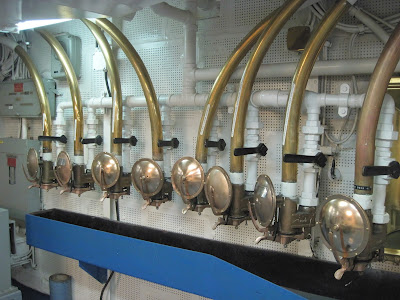The tall part of the ship that rises above the flight desk is called the Island.
It's the command center where the Captain worked, and it’s full of all sorts of gadgets crammed into as little space as possible.
Because of the tight space, they used glass panels to track information; the panels could just be folded out of the way when not needed. The guy who wrote on them was on the other side of the guy who needed to read it, so he had to write everything backwards.
We boarded the ship on the first of the lower decks, where the most changes have been made to accommodate tourists. There are the restrooms, information kiosks, gift shops, plus several planes on display. They often have a WWII veteran available to talk to the guests and answer questions. Today it was Ray Snyder, who was assigned to the Manhattan Project and was actually a witness to the Atomic Bomb tests at the Bikini Atoll.The deck of the ship is the flight deck, where the jets take off and land. I have often wondered about the odd shape of the desk, why it has one straight lane and one angled lane. It turns out there is a very good reason; the straight lane is where jets take off and the angled one is where jets land. On each side of the ship is a huge lift, big enough to sit a couple of jets on and bring them up to the flight deck level.
There are a few last-minute items, like removing the “do not fire” strap from the missels. I didn’t know they had these, but apparently if you don’t remove the strap, the missel won’t fire.
Naturally they use a lot of hand signals out there. My favorite is the “two-hands-in-the air” which, according to our docent, is really a way of saying “I'm not touching the release button!”.
Near the end of the process someone is assigned to judge the swells of the ocean against the time it will take the jet to get to the end of the ship. Judge wrong, and the jet reaches the take off point when the ship is pointed down; not a good idea.
The end of the tool includes a metal “dog bone”, which looks like a small dumbbell. One end of the dog-bone is permanently embedded in the tool and the other end is attached to a latch under the jet. When the checklist is completed, the guy with his hands in the air has his moment. He pushes a button to lift the small catapult behind the jet wheels. That, combined with the jet engine, is enough to break the dog-done. And the jet takes off. So the actual launch of a jet is dependent on this little piece of metal breaking apart at a pre-determined point of thrust.
Landing is just as tricky, but with less steps. The cable that catches the jets have to be set differently for each type of jet (and jets land about every 45 seconds), and the jet has to perfectly hit the right spot. That's all - easy!
Some of the jets have foldable wings - these are the ones that need that "unfold and lock wings' step in the take-off checklist!
The Huey Gunship Assault Helicoper looks like it means business, with these weapons mounted on the sides.
And the E-2 Hawkeye Airborn Early Warning aircraft has an overhead radar dish that looks like it borrowed it's design from the Star Trek Enterprise.
Lower levels of the ship are filled with everything needed for this city-on-water, including a chapel, sick bay, dental and x-ray rooms, laundry, office quarters and crew quarters. They used pneumatic message tubes to send the printed radio messages where needed; I like that they called them “Bunny Tubes”!
The radio control room is dated, of course, filled with banks and banks of knobs to tune receivers and patch panels.
And the kitchen, of course, is very important. The Admiral and Captain each have their own small kitchen, while the main kitchen is one of the biggest areas on the ship.
We finished our tour by watching a 15 minute video presentation about the Battle of Midway. The narrator in the video was pilot George Gay, the only survivor from the 15 planes in Squadron 8. Although the US won a decisive, critical victory that day, it was not without the loss of 307 people and 145 aircraft.
When the ship was decommissioned, she became a museum to the times, people and politics of our past. It's a great ship, and well worth the trip.
We finished the day with dinner at Mike and Maria's house. They make some great burgers and fries, and most of the rest of the family was there, too. Tina was still visiting from Oklahoma, Butch and Lina were there with Lina's sister and brother-in-law, plus Melissa and Ethan, and of course Mitchell. It was a perfect ending to a wonderful day.
When the ship was decommissioned, she became a museum to the times, people and politics of our past. It's a great ship, and well worth the trip.
We finished the day with dinner at Mike and Maria's house. They make some great burgers and fries, and most of the rest of the family was there, too. Tina was still visiting from Oklahoma, Butch and Lina were there with Lina's sister and brother-in-law, plus Melissa and Ethan, and of course Mitchell. It was a perfect ending to a wonderful day.
















No comments:
Post a Comment